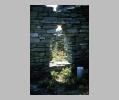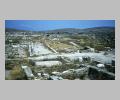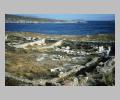| Summary: | Panhellenic Sanctuary of Apollo and Artemis. |
| Type: | Sanctuary, Settlement |
| Region: | Cyclades |
Periods:
Dark Age
Geometric
Archaic
Classical
Hellenistic
Roman
Physical:
The sanctuary occupies a small (1.3 x 5 km) island at the center (between Rheneia and Mykonos) of the Cycladic group and was the political and religious center of the Aegean.
It was said to be the birthplace of Apollo and Artemis. Its oracle was second only to that of Delphi. Delian Festival and Games held every 4 years. In addition to the Hieron of Apollo adjacent to the Sacred Lake, the temples and monuments to other divinities and the sanctuary of foreign gods, there was also a thriving residential district and maritime quarter to the south.
Description:
Evidence for settlement on Delos goes back the Early Bronze Age. In the later prehistoric period it was, according to legend, a stronghold of Carian pirates until they were driven off by King Minos of Crete.
The cult of Apollo appeared on the island in the Dark Ages and by the Archaic period (when the island was apparently under the control of Naxos), Delos served as the headquarters and religious center of an Ionian League. A religious festival (the Delia) was held (originally every year) to celebrate the birth of Apollo.
Athens, a member of the Ionian League, gained control over the sanctuary and under Peisistratos (ca. 543 B.C.) instigated the first purification of the island (the removal of all tombs in view of the temple). In 490 B.C. the Delians fled to Tenos, but the Persians did not violate the sanctuary.
Delos was made the center of the Athenian controlled Delian League (the alliance of Greek states against future Persian threat) and from 478-454 maintained the treasury of the league (until it was transferred to Athens and partially misappropriated for the rebuilding of the Acropolis). In 426 Athens reorganized the site and festival on an even larger scale and ordered the second purification of the island (the dead were exhumed and removed and a decree passed against birth, death, and pain on the island). In 422 Athens banished the remaining Delians from the island (on the intervention of the Delphic oracle they were allowed to return). Every year Athens sent a sacred embassy by trireme to the Delia festival. At the end of the Peloponnesian War Sparta restored independence to the Delians, but at the time of the 2nd Athenian League (378-314 B.C.) Athens again controlled the sanctuary and island.
Delos is again independent from ca. 314 until 166 B.C. It becomes the center of an island confederacy and enters the most prosperous period of its history. The Hellenistic kings provided many new buildings and offerings for the sanctuary, which was now under the control of 4 Hieropes (priest-administrators) elected annually by the Delians. The financial and trading activities of the island grew while foreign merchants and bankers, especially Roman, settled and installed sanctuaries to foreign deities on the island. In 166 B.C. the Delians were expelled and Rome allowed Athenians to occupy the island. Delos was made a free port (to undermine the commercial position of Rhodes) and in 146 B.C. the destruction of Corinth and the immigration of Corinthian merchants to Delos added to the island's growth. The religious aspects of the island gave way to commercial interests and the Apollo festival became essentially an international trade fair, with as many as 10,000 slaves changing hands in a single day.
In 88 B.C. Menophanes, a general of Mithradates attacked the island, killed or enslaved the population, looted the sanctuary and destroyed the city. In 87 B.C. Sulla retook the island, returned it to Athenian control and aided in its rebuilding. In 69 B.C. Delos was sacked by pirates, and in 66 B.C. the Romans built a fortification wall around the city. The sanctuary and the commercial center, however, continued to decline (in part because of changes in Roman trade routes) and suffer pirate attacks, and by the 2nd century A.D. it was all but abandoned. In the 3rd century A.D. Athens offered the island for sale, but found no buyers.
Exploration:
Excavations: 1873 - present, French School of Archaeology.
Sources Used:
Other Bibliography:





